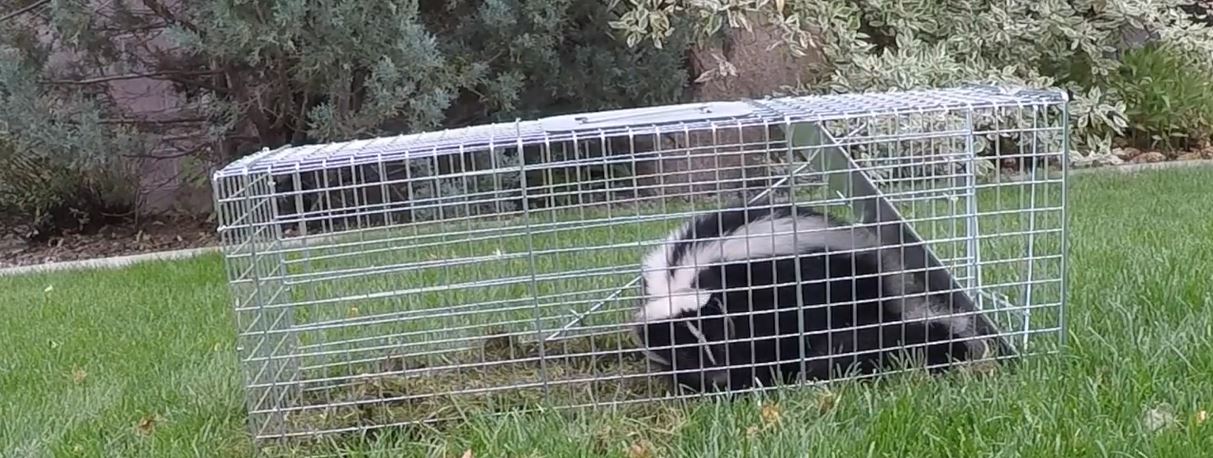Skunk Trapping: How To Trap A Skunk

If you have noticed a skunk on your property, you may be concerned about potential damage or even being sprayed. One of the best methods of ensuring the skunk doesn't bother you again in the future is trapping and relocating it, which it is frequently possible to do yourself. Before trapping a skunk, however, it is important to consult your local regulations. Some areas have restrictions on who is allowed to trap wild animals, how you can do it, or where you can release them and you do not want to end up with a fine or worse. If trapping is legal in your area, there are some basic steps you will want to follow.
Trap Types
There are two general types of traps that you can use for catching a skunk: live traps or kill traps. Kill traps will kill the skunk right away and are typically in the form of body grip traps. These traps are frequently considered inhumane because they are not always effective and if the skunk doesn't die right away, it will have a painful experience. Kill traps also pose the risk of catching a cat, dog, or other domestic animal and causing severe injuries.
Live traps are always the better option as they allow you to keep the skunk alive while removing it from your property. There are several variations of traps, but most will have a door on one end with a spring. When the skunk steps on a plate in the trap, this triggers the spring and the door shuts. Keep in mind that each trap will only hold one skunk so you will need several traps if multiple skunks are present.
Baits To Use
Skunks will eat a wide range of items, but their strong sense of smell and preference for oily, meat-based baits makes some bait options better than others. Some ideas include canned sardines, chicken entrails, fresh insect larvae, cat food, crisp bacon, canned tuna, peanut butter on bread, and marshmallows. Remember that for the best results, you will want to place a line of bait leading up to the trap with a greater quantity inside.
Placing The Trap
Placement of the trap is crucial as you are unlikely to catch the troublesome skunk if it never walks by the trap. If you know where the skunk dens or has a burrow, then try placing the trap by the exit of that area. Always make sure that your trap isn't somewhere where you will accidentally catch domestic animals.
Ideal Methods
The best time to set up a trap would be right before dusk or at night since skunks are nocturnal animals. You will want to check the trap in the morning so the animal is not stuck inside for too long. The process of setting up the trap is fairly simple. You need to make sure you are familiar with it, select the appropriate bait and location, and then place the trap in the ideal spot with the bait inside.
Special Tips To Avoid Being Sprayed
When catching most wild animals, your main concern is avoiding being bitten or scratched when handling the trap. There is an additional issue with skunks in the form of their foul-smelling spray. Because skunks can spray up to a distance of 10 feet, you need to be especially careful to avoid this issue. The skunk will give you warning signs before it sprays, such as pointing its rear end in your direction, stamping its feet, and raising its tail. If you notice these signs, back away.
To avoid getting sprayed by the skunk, you will want to cover the trap with a cloth of some sort since skunks will not usually spray you if they can't see you. This is sometimes easier said than done, but the best method is to slowly approach the cage from the back and drop the cloth on top of it. This will allow you to later move the skunk with minimal risk of being sprayed.
Where To Relocate
As with trapping regulations, some cities, counties, or states have particular regulations regarding where you can release a skunk to relocate. Assuming it is legal in your area, you should drive a minimum of five miles away from your home to relocate the skunk to reduce its risk of returning. Try to select an area where the skunk will have ready access to food and shelter with a water source nearby.
Other Considerations
In addition to avoiding being sprayed and checking local regulations before trapping and relocating a squirrel, you want to consider a few other factors. During the spring or summer, baby skunks may be present and if this is the case, you do not want to separate them from their mother. You should ideally wait for them to mature enough to live on their own, but if this is not possible, you will need to trap all babies as well as the mother. In this situation, you may want to consider hiring a professional. After trapping the skunks, remember to prevent new ones from taking their place. You can do this by making your property unattractive by removing potential food and shelter.
Read the How to get rid of skunks page for helpful information and to learn more about Skunk Trapping: How To Trap A Skunk

